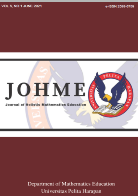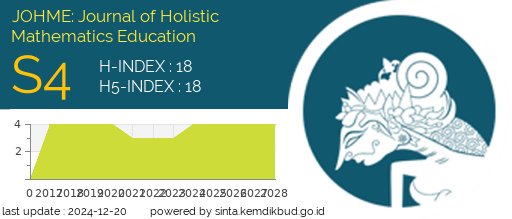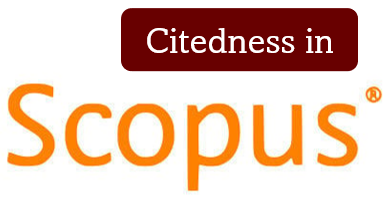PERAN GURU KRISTEN DALAM MENUNTUN SISWA MEMANDANG MATEMATIKA [THE ROLE OF CHRISTIAN TEACHERS IN GUIDING STUDENTS TO VIEW MATHEMATICS]
DOI:
https://doi.org/10.19166/johme.v5i1.3363Λέξεις-κλειδιά:
Christian, the beauty of mathematics, the usefulness of mathematics, teachers, students, Kristen, keindahan matematika, kegunaan matematika, guru, siswaΠερίληψη
Mathematics is a subject that is considered a scourge by most students. They think that mathematics is difficult, complicated, and boring. However, if we look at the process of creation, everything in this universe (including mathematics) is God's creation and everything is really good. This truth needs to be revealed to students by the mathematics teacher. Unfortunately, many math teachers make students dislike mathematics. Therefore, this paper aims to describe the role of Christian mathematics teachers to guide students in viewing mathematics according to God's perspective. The research method used is the literature study method. The results of this study indicate that the role of Christian mathematics teachers includes: (1) appreciating and exploring mathematics first; (2) developing the four teacher competencies; and (3) understand the objectives of learning mathematics. Christian mathematics teachers also need to be careful not to fall into the sin of idolatry and pride by asking the Holy Spirit for help to be enabled in each of their ministries.
BAHASA INDONESIA ABSTRACT: Matematika merupakan salah satu mata pelajaran yang dianggap momok oleh siswa. Siswa menganggap bahwa matematika itu sulit, rumit, dan membosankan. Namun jika melihat pada proses penciptaan maka segala yang ada di alam semesta ini (termasuk matematika) merupakan ciptaan Allah dan semuanya sungguh amat baik. Kebenaran ini perlu disingkapkan kepada siswa oleh guru matematika. Namun, banyak guru matematika yang justru membuat siswa tidak menyukai matematika. Oleh sebab itu, tulisan ini bertujuan untuk memaparkan peran guru matematika Kristen di dalam menuntun siswa dalam memandang matematika sesuai dengan cara pandang Allah. Adapun metode penelitian yang digunakan adalah metode studi kepustakaan. Hasil penelitian ini memaparkan bahwa peran guru matematika Kristen meliputi: (1) mengapresiasi dan menjelajahi matematika terlebih dahulu; (2) mengembangkan keempat kompetensi guru; serta (3) memahami tujuan pembelajaran matematika. Guru matematika Kristen juga perlu berhati-hati agar tidak jatuh ke dalam dosa penyembahan berhala dan kesombongan dengan meminta pertolongan kepada Roh Kudus agar dimampukan dalam setiap pelayanannya.
Αναφορές
Astika, M., & Bunga, S. S. (2016). Hubungan kompetensi sosial guru Kristen terhadap perkembangan karakter siswa: Tantangan pendidikan Kristen dalam mencerdaskan youth generation. Jurnal Jaffray, 14(1), 63-76. https://doi.org/10.25278/jj71.v14i1.189
Berkhof, L., & van Til, C. (2004). Dasar pendidikan Kristen. Surabaya, Indonesia: Momentum.
Boaler, J. (2006). How a detracked mathematics approach promoted respect, responsibility, and high achievement. Theory Into Practice, 45(1), 40-46. https://doi.org/10.1207/s15430421tip4501_6
Casey, M., Nuttall, R., & Pezaris, E. (2001). Spatial mechanical reasoning skils versus mathematics self-confidence as mediators of gender differences on mathematics subtests using cross-national gender-based items. Journal for Research in Mathematics Education, 32(1), 28-57. https://doi.org/10.2307/749620
Dirgantoro, K. P. (2018). Kompetensi guru matematika dalam mengembangkan kompetensi matematis siswa. Scholaria: Jurnal Pendidikan dan Kebudayaan, 8(2), 157-166. https://doi.org/10.24246/j.js.2018.v8.i2.p157-166
Federer, B. (2018). World Tribune. Retrieved from https://worldtribune.com/life/early-astronomers-mathematics-is-the-language-in-which-god-has-written-the-universe/
Grootenboer, P. (2001). How students remember their mathematics teachers. Australian Mathematics Teacher, 57(4). Retrieved from core.ac.uk/display/143849070
Hernadi, J. (2008). Metoda pembuktian dalam matematika. Jurnal Pendidikan Matematika, 2(2), 1-13. Retrieved from http://repository.unsri.ac.id/id/eprint/23421
Inglis, M., & Aberdein, A. (2015). Beauty is not simplicity: An analysis of mathematicians' proof appraisals. Philosophia Mathematica, 23(1), 87-109. https://doi.org/10.1093/philmat/nku014
Izzan, A. (2012). Membangun guru berkarakter. Bandung, Indonesia: PT. Humaniora Utama Press.
Lane, C., Stynes, M., & O’Donoghue, J. (2014). The image of mathematics held by Irish post-primary students. International Journal of Mathematical Education in Science and Technology, 45(6), 879-891. https://doi.org/10.1080/0020739x.2014.884648
Leder, G., & Forgasz, H. (2010). I liked it till Pythagoras: The public’s views of mathematics. In L. Sparrow, B. Kissane, and C. Hurst (Eds.). Proceedings of the 33rd annual conference of the Mathematics Education Research Group of Australasia, 328-335. Fremantle, Australia: MERGA.
Mallison, B. (2019). Faith, mathematics, and science: The priority of scripture in the pursuit and acquisition of truth. ACMS 22nd Biennial Conference Proceedings, 93-115. Indiana: Indiana Wesleyan University. Retrieved from https://acmsonline.org/
Mann, E. L. (2006). Creativity: The essence of mathematics. Journal for the Education of the Gifted , 30(2), 236-260. https://doi.org/10.4219/jeg-2006-264
Markovits, Z., & Forgasz, H. (2017). 'Mathematics is like a lion': Elementary students' beliefs about mathematics. Educational Studies in Mathematics, 96(3), 49-64. https://doi.org/10.1007/s10649-017-9759-2
MartÃnez-Sierra, G., Arellano-GarcÃa, Y., Hernández-Moreno, A., & Nava-Guzmán, C. (2018). Exploring daily emotions of a mathematics teacher in a classroom: The case of Christian. CERME, 10, 1154-1161. Dublin,Ireland.
Picker, S., & Berry, J. (2001). Your students’ images of mathematicians and mathematics. Mathematics Teaching in the Middle School, 7(4), 202-208. Retrieved from https://eric.ed.gov/?id=EJ672176
Poythress, V. (2015). Redeeming mathematics: A God-centered approach. Illinois: Crossway.
Stiles, D., Adkisson, J., Sebben, D., & Tama. (2008). Pictures of hearts and daggers: Strong emotions are expressed in young adolescents’ drawings of their attitudes towards mathematics. World Cultures e-Journal, 16(2). Retrieved from https://escholarship.org/uc/item/1sq263b7
Sujarweni, V. W. (2014). Metodologi penelitian. Yogyakarta, Indonesia: Pustaka Baru Press.
Suryadi. (2007). Pendidikan matematika dalam ilmu dan aplikasi pendidikan. Bandung, Indonesia: Imperial Bhakti Utama.
Tarigan, M. S. (2019). Implikasi penebusan Kristus dalam pendidikan Kristen. Polyglot: Jurnal Ilmiah, 15(2), 203-222. https://doi.org/10.19166/pji.v15i2.1409
Tety, & Wiraatmadja, S. (2017). Prinsip-prinsip filsafat pendidikan Kristen. Evangelikal: Jurnal Teologi Injili dan Pembinaan Warga Jemaat, 1(1), 55-60. https://doi.org/10.46445/ejti.v1i1.56
Uno, H. B. (2014). Model pembelajaran menciptakan proses belajar mengajar yang kreatif dan efektif. Jakarta, Indonesia: Bumi Aksara.
van Brummelen, H. (2008). Batu loncatan kurikulum. Tangerang, Indonesia: Universitas Pelita Harapan Press.
Whelchel, H. (2015). Mengubah dunia melalui kerja. Jakarta, Indonesia: Waskita Publishings.
Yazlik, D., & Erdogan, A. (2016). Image of the high school students towards mathematicians. Journal of Educational and Instructional Studies in the World, 6(4), 1-14. Retrieved from https://www.researchgate.net/publication/312041759_IMAGE_OF_THE_HIGH_SCHOOL_STUDENTS_TOWARDS_MATHEMATICIANS
Zed, M. (2008). Metode penelitian kepustakaan. Jakarta, Indonesia: Yayasan Obor Indonesia.
Zeki, S., Romaya, J. P., Benincasa, D. M., & Atiyah, M. F. (2014). The experience of mathematical beauty and its neural correlates. Frontiers in Human Neuroscience, 8, 1-12. https://doi.org/10.3389/fnhum.2014.00068Λήψεις
Επιπλέον Αρχεία
Δημοσιευμένα
Πώς να δημιουργήσετε Αναφορές
Τεύχος
Ενότητα
Άδεια
Authors who publish with this journal agree to the following terms:
1) Authors retain copyright and grant the journal right of first publication with the work simultaneously licensed under a Creative Commons Attribution License (CC-BY-SA 4.0) that allows others to share the work with an acknowledgement of the work's authorship and initial publication in this journal.
2) Authors are able to enter into separate, additional contractual arrangements for the non-exclusive distribution of the journal's published version of the work (e.g., post it to an institutional repository or publish it in a book), with an acknowledgement of its initial publication in this journal.
3) Authors are permitted and encouraged to post their work online (e.g., in institutional repositories or on their website). The final published PDF should be used and bibliographic details that credit the publication in this journal should be included.”










